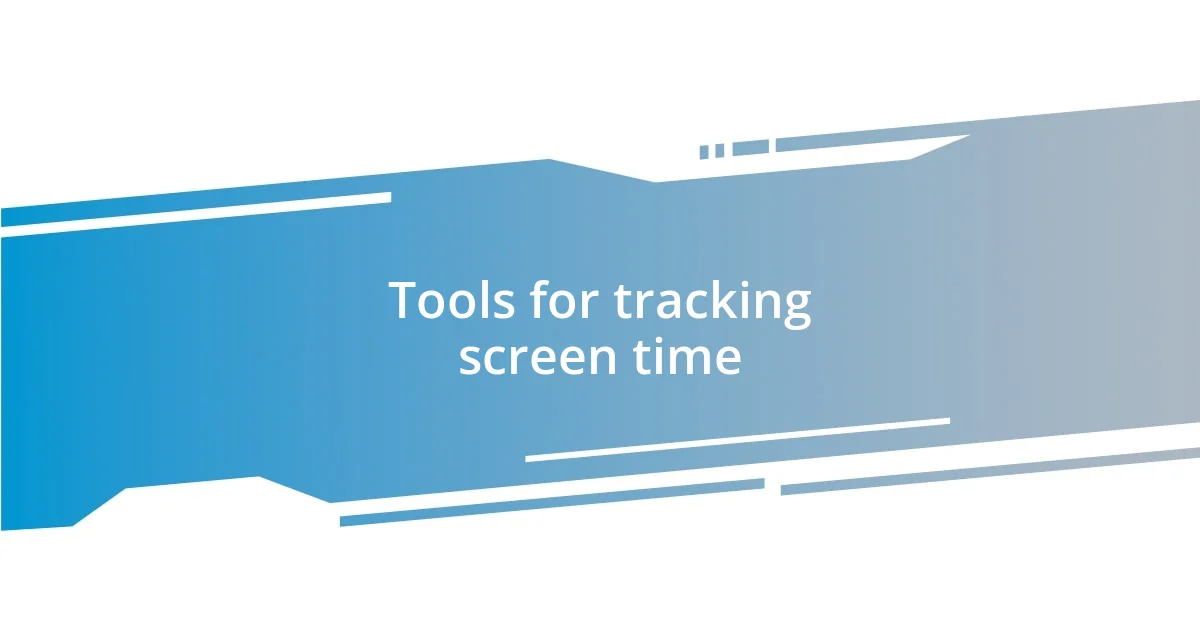Key takeaways:
- Setting screen time limits fosters better mental health, productivity, and real-life connections by prioritizing quality interactions over passive consumption.
- Utilizing tracking tools like Screen Time or Digital Wellbeing can help individuals visualize their usage patterns and encourage more mindful technology engagement.
- Implementing strategies such as tech-free zones, accountability with friends or family, and engaging in offline hobbies enhances well-being and appreciation for life outside screens.

Understanding screen time limits
Understanding screen time limits is more than just setting a timer; it’s about recognizing the impact that digital devices can have on our lives. I remember a time when I lost track of hours scrolling through social media, realizing weeks later that I hadn’t picked up a book in ages. It makes me wonder—how often do we let our screens dictate our time rather than making intentional choices about our activities?
When we talk about screen time limits, we must consider both the quality and quantity of that time. Not all screen experiences are created equal, and I once found that educational videos sparked more creativity in me than mindless gaming. Have you ever noticed how a thoughtful documentary can stay with you long after watching, while endless scrolling often leaves you feeling drained?
Setting screen time limits is essential, but it’s equally important to communicate why those limits matter. I’ve found that discussing the reasons behind my own rules with friends and family helps us all stay accountable. What are we really missing out on when we’re glued to our devices—those meaningful conversations, the moments spent in nature, or even just time to think?

Importance of screen time management
Managing screen time is crucial for maintaining a balanced lifestyle. I recall a week when I went without any screen limits; the fatigue and irritability that crept in were surprising. It was a stark reminder of how screens can overwhelm our well-being if left unchecked. Thoughtful management can foster healthier relationships with the digital world and improve overall mental clarity.
Here are some key reasons to prioritize screen time management:
- Mental Health: Overexposure to screens can lead to anxiety and depression. I noticed that limiting my time on social media lifted my mood significantly.
- Focus and Productivity: When I consciously reduced my screen time, I found it easier to concentrate on tasks and complete projects efficiently.
- Physical Health: Reducing screen time promotes better posture and sleep quality. I’ve been more mindful of my evening routines since I started putting my devices away before bed.
- Quality Time: By setting limits, I’ve prioritized family moments, like board games, that create lasting memories.
- Creativity Enhancement: Less screen time creates space for creativity. I’ve returned to hobbies like painting and writing, which I had overlooked for too long.

Tools for tracking screen time
There are several tools available today that can help track screen time effectively. Personally, I started using an app called Screen Time and found it incredibly helpful in visualizing my daily usage. It provided insights that prompted me to reflect on whether that evening scrolling session was worth the time lost. Have you ever checked your screen time and felt a mix of surprise and guilt? Tracking tools make those feelings more tangible.
In my experience, many devices come equipped with built-in features to monitor usage. For instance, I discovered the Digital Wellbeing setting on my Android phone, which tracks app usage and notifications. It’s fascinating to see which apps consume most of my time, and I even turned on reminders to take breaks. These simple features can be game-changers, allowing us to reclaim hours we didn’t know we were losing.
Let’s not forget about third-party apps. Tools like RescueTime can provide detailed reports on how we spend our time online. I remember the first report I received; it was eye-opening to see how much time I spent on gaming versus reading. This kind of analysis empowers users—it puts control back into our hands by helping to make conscious choices about how we engage with technology.
| Tool | Description |
|---|---|
| Screen Time | Tracks overall screen time and app usage on iOS devices, providing weekly reports. |
| Digital Wellbeing | Android feature that monitors app usage, screen time, and allows users to set usage limits. |
| RescueTime | A third-party app that analyzes how you spend your time on digital devices and provides productivity reports. |

Strategies for reducing screen time
Finding strategies to reduce screen time involves a bit of trial and error, but I’ve discovered a few effective methods that really resonate with me. One strategy I found invaluable is setting specific “no-screen” hours—especially during mealtimes or before bed. I often feel more connected to my family during dinner without distractions, and it’s amazing how much genuine conversation flows when screens are put aside. Have you tried this? It can be a game changer!
Another approach I implemented was to replace screen time with engaging offline activities. I took up gardening recently, which not only keeps me away from my phone but also nurtures my well-being. There’s something remarkably restorative about digging in the dirt and watching things grow. Have you thought about revisiting old hobbies or discovering new ones? It feels so rewarding to invest my time in things that feed my soul rather than just my screen.
Lastly, I believe accountability can make a big difference. Sharing my goals with friends or family creates a support network that keeps me on track. I remember discussing my screen time reduction goals with a close friend who then shared her own journey, turning it into a light-hearted challenge. This social aspect reinforces my commitment in a fun way, and I’ve found it easier to stick to my limits when I’m not alone. Have you ever had someone on your journey with you? It can really help to have that extra push.

Benefits of screen time limits
Setting screen time limits can lead to remarkable improvements in our daily lives. I remember the first time I restricted my Instagram usage to just 30 minutes a day. It felt strange at first, but soon I noticed I had more time for morning walks and reading before bed, contributing to a greater sense of peace and well-being. Have you ever felt the overwhelming rush of scrolling, only to look up and realize hours have evaporated?
Another benefit is better sleep quality. I used to mindlessly scroll through my phone right before bed, and that blue light just kept me awake longer than I’d like to admit. After establishing a rule to put the phone down an hour before sleep, I found myself sleeping more soundly and waking up refreshed. It’s amazing how that small change can make such a significant difference—don’t you feel more energized after a good night’s sleep?
Lastly, limiting screen time can enhance real-life connections. I’ve noticed that when I put my phone away during social gatherings, I engage more meaningfully with others. There’s something special about eye contact and shared laughter that a screen simply can’t replicate. Have you considered how the absence of screens might alter your interactions with family and friends? It truly fosters a deeper sense of connection and belonging.

Creating a balanced digital lifestyle
Creating a balanced digital lifestyle is all about finding that sweet spot between our virtual and real worlds. I’ve found that designating tech-free zones in my home, like the living room or bedroom, has been incredibly beneficial. It’s breathtaking how simply unplugging in these spaces allows for richer family interactions and a sense of calm that’s often hard to find amidst the notifications and alerts.
Engaging in outdoor activities has also helped me reconnect with my surroundings. I remember the first time I took a nature walk without my phone; I was surprised by how much I noticed—the rustling leaves, the colors of the flowers, and even the sound of my own thoughts. Isn’t it fascinating how stepping away from screens lets us appreciate the beauty around us? I often think about how much we miss when our focus is glued to a screen rather than the world unfolding in front of us.
Lastly, setting personal goals around technology use has kept me motivated. For instance, I’ve committed to a “digital detox” day once a month, where I completely disconnect from all screens. The first time I did it, I felt a bit lost, but by the end of the day, I was amazed at how much I enjoyed reading, cooking, and even journaling my thoughts. Have you ever considered that giving yourself a break could lead to discovering new passions? It’s refreshing to step away from the screen and engage with life more fully.
















